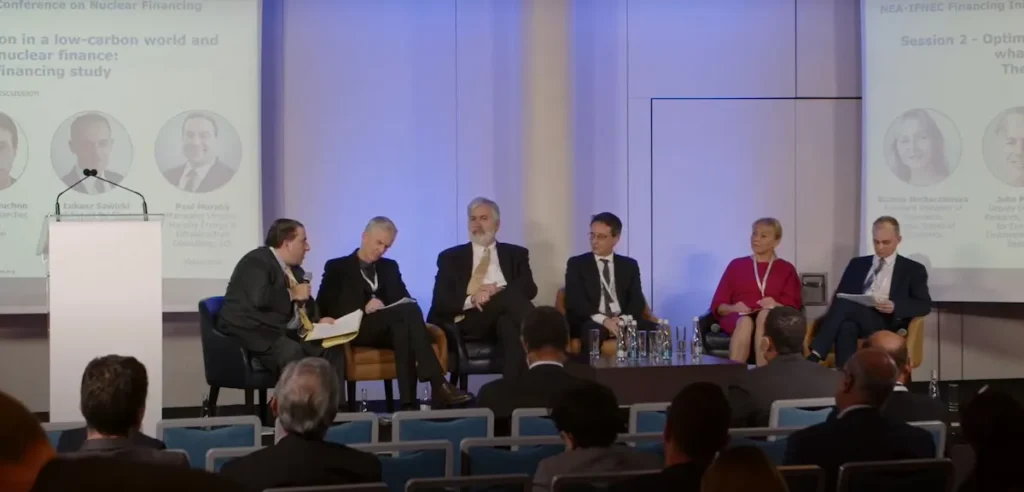
Dr. Bożena Horbaczewska and Łukasz Sawicki took part in the panel discussion of session 2 at the 'NEA-IFNEC Financing Initiative: Warsaw Conference on Nuclear Financing’ held in Warsaw on 8 December 2022.
This session, entitled Optimal risk allocation in a low-carbon world and what it means for nuclear finance: the NEA nuclear financing study, also featured:
- Jan Horst Keppler, Chief Energy Economist, NEA
- John Parsons, Deputy Director for Research, MIT Center for Energy and Environmental Policy Research
- Benoît Peluchon, Senior Researcher, EDF, France
- Paul Murphy, Managing Director, Murphy Energy & Infrastructure Consulting, LLC – as a moderator
Łukasz Sawicki pointed out the relationship between the appropriate risk allocation in a nuclear project and the cost of electricity generation and, further, the impact on end-user bills. He noted that different business models used in nuclear power and considered in Poland, allocate risk and distribute the benefits of NPP operation differently. For example, in the SaHo Model, the benefits at the construction stage (the difference between the buying and selling share prices) go to those who bear the investment risk and the cost of construction, e.g. primary investors. At the operation stage, the benefits go to the owners who bear the operational risk, i.e. the end-users.
Dr. Bożena Horbaczewska pointed out that thinking about risk allocation, we should draw lessons from the 2008 global financial crisis. The root cause of the crisis was that risks were ignored and hidden in various financial products, making it difficult to assess the risk level and analyse them reliably. As the crisis unfolded, financial institutions turned to the state for help. The SaHo Model is based on the opposite assumption, that is, the state assumes the investment risk from the beginning, rather than 'putting out the fire’ caused by the private investor. Dr. Horbaczewska referred to the new NEA report, which addresses issues of so-called de-risking of the project, i.e. reducing investment risk. She said that once the SaHo Model is implemented, investors interested in NPP shares can use the risk estimation methods described in the report.
Paul Murphy asked how the Polish government, particularly the nuclear regulator, was going to deal with plans to build a significant number of reactors (both large and small) simultaneously, while maintaining safety requirements. – There is indeed a major challenge and 'headache’ for our nuclear regulator. The National Atomic Energy Agency (PAA) has been hiring more and more people for some time. On the other hand, nuclear investors are submitting more and more documentation to the regulator. The agency is putting a lot of effort into training its experts and has training agreements in place with, among others, the US NRC. If documentation is to be submitted for the APR1400 and SMR reactors, close cooperation with the nuclear regulatory authorities of other countries will also be necessary. On the other hand, from the viewpoint of investment risk, it is important to make the licensing process transparent and to involve dialogue between the investor and the PAA. The discretionary approach that was characteristic of the nuclear regulatory authorities in the 1990s in the post-Chernobyl era should be avoided. This modern approach is already being applied by the PAA in Poland and can reduce investment risk, said Łukasz Sawicki.
Paul Murphy asked Dr. Horbaczewska how the SaHo Model addresses the provision of energy security and critical infrastructure facilities. – Energy security is a public good and the delivery of public goods is primarily the responsibility of the state. In the SaHo Model it is the state that sets up the nuclear SPV, organises the financing, assumes most of the risk, and when that risk decreases then the state can transfer ownership to private investors. However it can still retain some form of control over the company – noted Dr. Horbaczewska. She also referred to the human resources issue for i.a. the Polish nuclear regulator and informed about the launch of postgraduate studies in nuclear power at the SGH Warsaw School of Economics.
Paul Murphy and Jan Horst Keppler asked the Authors of the SaHo Model what is the best time to change ownership of NPP from state to private. – This issue should be detailed in discussions between the government and end-user organisations. A similar format of dialogue with large industrial consumers was used for the Exeltium project in France, said Łukasz Sawicki.
The conference agenda is available on the NEA website: https://www.oecd-nea.org/jcms/pl_75386/nea-ifnec-financing-initiative-warsaw-conference-on-nuclear-financing
The video record is available below: